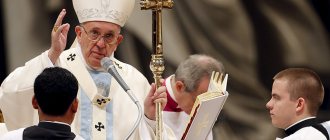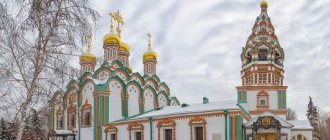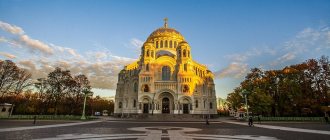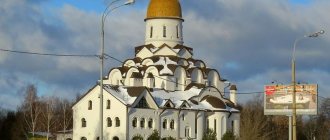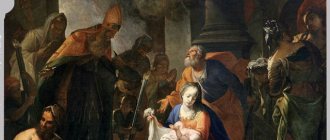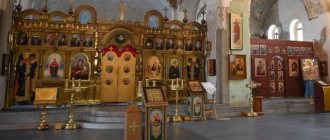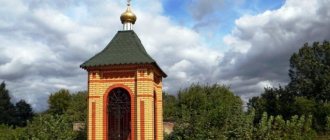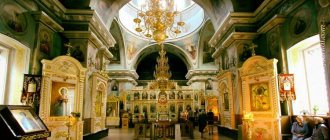| Temple structure |
Orthodox Church
According to patristic teaching, the Orthodox Church is the House of God, in which the Lord invisibly dwells, surrounded by a host of angels and saints. The Lord Himself gave people instructions in the Old Testament on what a temple should be like for worship; The New Testament Orthodox church is built according to the model of the Old Testament.
Just as the Old Testament temple (in the beginning, the Tabernacle of the Covenant) was divided into three parts: the Holy of Holies, the sanctuary and the courtyard, so the Orthodox Christian temple is divided into three parts: the altar, the middle part of the temple (ship) and the vestibule. Just as the Holy of Holies then meant, so now the altar means the Kingdom of Heaven. In the Old Testament, only the high priest could enter the Holy of Holies, and then only once a year, and only with the blood of a cleansing sacrifice. After all, the Kingdom of Heaven was closed to man after the Fall. The High Priest was a prototype of Christ, and this action of his signified to people that the time would come when Christ, through the shedding of His Blood and suffering on the Cross, would open the Kingdom of Heaven to everyone. That is why, when Christ died on the Cross, the curtain in the temple that covered the Holy of Holies was torn in two: from that moment on, Christ opened the gates of the Kingdom of Heaven for all who come to Him with faith.
The middle part of the temple corresponds to the sanctuary in our Orthodox church. No one had the right to enter the sanctuary of the Old Testament temple except the priests. All Christian believers stand in our church, because now the Kingdom of God is closed to no one. The courtyard of the Old Testament temple, where all the people were, corresponds in an Orthodox church to the refectory or vestibule, the third part of the temple, attached to it, unlike the altar, not from the east, but from the west. Previously it was intended for persons who did not have the right to enter the temple. Here stood the catechumens who, while preparing to become Christians, had not yet received the sacrament of Baptism. Then, sometimes, those who seriously sinned and apostatized from the Church. They were temporarily sent to stand in the vestibule for correction. Now, in this regard, the vestibule has no significant significance.
Orthodox churches are built with the altar facing east - towards the light, where the sun rises: the Lord Jesus Christ is the “East” for us, from Him the eternal Divine Light has shone for us. In church prayers we talk about Jesus Christ: “Sun of Truth”, “from the heights of the East”, “East from above”, “East is His name”.
Each temple is dedicated to God, bearing a name in memory of one or another sacred event or saint of God, for example, Trinity Church, Transfiguration, Ascension, Annunciation, Pokrovsky, Michael-Arkhangelsk, Nikolaevsky, etc. If several altars are installed in a temple, each of them is consecrated in memory of a special event or saint. Then all the altars, except the main one, are called side altars, or chapels (an extension to the main temple, which has its own altar and a special altar in it).
The Temple of God differs in appearance from other buildings. For the most part, the temple at its base is arranged in the form of a cross. This means that the temple is dedicated to the Lord crucified on the Cross for us and that through the Cross the Lord Jesus Christ delivered us from the power of the devil. Often the temple is built in the form of an oblong ship, which means that the Church, like a ship, in the image of Noah’s Ark, saves us from the raging sea of life and leads us to a quiet, reliable harbor in the Kingdom of Heaven. Sometimes the temple is arranged in the form of a circle, this reminds us of the eternity of the Church of Christ. The temple can also be built in the form of an octagon, like a star, meaning that the Church, like a guiding star, shines in this world.
The temple building is usually topped with a dome, representing Heaven. The dome ends at the top with a chapter on which a cross is placed in honor of the Head of the Church - Jesus Christ. Often, not one, but several chapters are placed on the temple, then: two chapters mean two natures (Divine and human) in Jesus Christ, three chapters - the three Persons of the Holy Trinity, five chapters - Jesus Christ and the four evangelists, seven chapters - the seven sacraments and seven ecumenical councils, nine chapters - nine ranks of angels, thirteen chapters - Jesus Christ and the twelve apostles, and sometimes they put a larger number of chapters.
“If a pagan asks you what your faith is, take him to church and show him the icons,” says the Rev. John of Damascus. Icons serve not only as decoration for the splendor of the temple, but also explain the dogmas of Orthodoxy and are inseparably linked with the Divine Liturgy. Therefore, the Fathers of the Church established a certain placement of sacred images, and this establishment is canonical for the Orthodox East.
Anyone who enters the church sees in the narthex an image of the prophets who foreshadowed the Incarnation of Christ, Old Testament events symbolizing His coming, or the Eternal Christ Emmanuel in the bosom of the Mother of God. An image of the Last Judgment is placed on the western wall of the narthex so that those leaving the church can take with them the thought of the inevitable end and think about their sins. In the ship, i.e. in the church itself, there are images of the Incarnate Christ the Savior in the hands of the Mother of God, the Holy Trinity, saints and angels. In the dome rises Christ Pantocrator, the Head of the Church, with the Gospel revealed in the words: “Come to Me, all you who labor and are heavy laden, and I will give you rest” (Matthew 11:28). Christ Pantocrator is the image of God the Father, because. Christ said: “Whoever has seen Me has seen the Father. I and the Father are One." Under the dome, in the four corners called “sails”, evangelists are depicted spreading the teachings of Christ throughout the world.
The “ship” where the parishioners stand is separated from the altar by an iconostasis. In addition to the iconostasis, icons are placed on the walls of the temple, and are also located on lecterns.
In the altar itself, high in the recess of the vault, there is an image of the Mother of God, Who is inseparable through the Incarnation from the Redemptive Sacrifice. Above the altar, where the Holy Gifts are prepared, there are icons: “Crucifixion”, “Entombment” or “Descent from the Cross”.
The placement of holy images, whether icons or paintings, reflects in harmonious continuity the dogmas of Orthodoxy: the inseparability and consubstantiality of the Holy Trinity, the Incarnation and the Redemptive Sacrifice of Christ.
Above the entrance to the temple, and sometimes next to the temple, a bell tower, or belfry, is built, that is, a tower on which the bells hang.
The most important part of the temple is the altar. In the altar, divine services are performed by the clergy and the most sacred place in the entire temple is located - the Holy Throne, on which the sacrament of the Sacrifice of the Body and Blood of Christ is performed. The altar is placed on a raised platform. It is higher than other parts of the temple, so that everyone can hear the service and see what is happening in the altar. The very word “altar” means “exalted altar.”
The Holy See is a specially consecrated quadrangular table, located in the middle of the altar and decorated with two clothes: the lower one is white, made of linen, and the upper one is made of more expensive material, mostly brocade. The Lord Himself is mysteriously, invisibly present on the throne as the King and Ruler of the Church. Only clergy can touch and kiss the throne.
On the throne are: the antimension, the Gospel, the Holy Cross, the tabernacle and the monstrance.
Behind the throne there is a seven-branched candlestick, that is, a candlestick with seven lamps, and behind it is an altar cross. The place behind the throne at the very eastern wall of the altar is called the mountain (high) place; it is usually made elevated.
To the left of the throne, in the northern part of the altar, stands the altar
The altar also contains censers, or censers, used for burning incense (incense). Ceremony was established in the Old Testament church by God Himself.
Ceremony before St. the throne and icons expresses our respect and reverence for them. Every prayer addressed to those praying expresses the wish that their prayer would be fervent and reverent and would easily ascend to Heaven, like incense smoke, and that the grace of God would overshadow the believers as the smoke of incense surrounds them. Believers respond to incense with a bow.
The altar also contains dikiriy and trikiriy, used by the bishop to bless the people, and ripids.
On the right side of the altar there is a sacristy. This is the name of the room where vestments are stored, i.e. sacred garments used during divine services, as well as church vessels and books with which divine services are performed.
The elevation on which the altar and iconostasis stand protrudes significantly forward into the middle part of the temple and is called the sole.
The middle of the solea, the elevation in front of the Royal Doors, is called the pulpit, i.e. climbing. At the pulpit, the deacon pronounces litanies (prayer requests) on behalf of the worshipers and reads the Gospel. On the pulpit is taught to believers and St. participle.
Along the edges of the soleya, near the walls of the temple, choir rooms are arranged for readers and singers.
Near the choirs there are banners - images of the Face of the Savior or the Most Holy Theotokos on fabric or metal, attached to long shafts. They are worn during religious processions as church banners.
The temple also has a “kanunnik”, which is the name of a low table on which there is an image of the Crucifixion and a stand for candles. Before the eve, memorial services are served, i.e. funeral services.
In front of the icons and lecterns there are candlesticks on which believers place candles.
In the middle of the temple, at the top of the ceiling, hangs a chandelier, i.e. large candlestick with many candles. The chandelier is lit during solemn moments of the service.
The temple (throne) holiday is celebrated on the day of remembrance of a saint or event in commemoration of which the throne was consecrated.
Meaning of the word temple
- the central and only place of worship of the Israeli people to their God, the house of the name of the Lord (1 Kings 5:5), built according to the will and drawings of David by his son Solomon in Jerusalem on Mount Moriah (2 Chronicles 3:1), then renewed by Zerubbabel and rebuilt by Herod ( cm.
below).
The temple replaced the tabernacle ( see
) when the people of Israel, after forty years of walking through the deserts, settled in the land of Canaan.
In Scripture, the tabernacle, which appeared as its prototype, is also called a temple (1 Sam. 1:9; 1 Sam. 3:3; Ps. 5:8; Ps. 27:4; Ps. 137:2), as well as the works and bodies of individual believers themselves. (1 Cor. 3:16 -17; 1 Cor. 6:19) and the Lord God Himself and His Lamb (Rev. 21:22; in the same sense, other references to the temple in the book of Revelation must be understood).
In relation to the Jerusalem Temple, this word refers to both only one middle part of the building (1 Kings 6:5,17,22; 2 Chronicles 3:13) and the entire building (1 Kings 6:10, etc.), as well as the entire complex of buildings along with all the courtyards and porticos. For when it is said that the Lord taught in the temple (Luke 19:45,47), then only courtyards are meant ( possibly
, only external), for, not being from the tribe of Levi and a priest, the Savior definitely did not enter the inner court and the temple building itself (also
see
Luke 2:27,37; Luke 18:10; Acts 3:1 ; Acts 5:20,25; Acts 21:26 -30; Acts 22:17; Acts 24:18; Acts 26:21).
In this regard, it should be noted that all images of the temple, similar to Orthodox churches or Catholic cathedrals, in which worshipers stand, are completely incorrect, because no one except the priests had the right to enter inside the building (very small and dark in size - see
below) . Everyone was praying in one of the outer courtyards.
The temple in many places is also called the house of God and the house of the Lord.
1. Temple of Solomon.
The first temple built in Jerusalem was very beautiful and rich. There was no other such beautiful structure on earth. It was compared to other places of worship of various deities as the sun is compared to small stars. Looking at the second temple during its construction, the old people who saw the first temple cried (Ezra 3:12).
It was spent on the temple (according to 1 Chronicles 22:14; 1 Chronicles 29:4,7): 3888.03 tons
gold, 36,612
tons
of silver, much more than 648
tons
of copper and more than 3,600
tons
of iron (
see
1 Kings 7:47; 1 Chronicles 22:14; iron).
The price of these materials alone (not counting precious stones - see
1 Chronicles 29:1,8, and other materials) is unheard of, both according to ancient and modern estimates.
For comparison, we can recall that the pay of a soldier and a day laborer is 1.00 .
equaled approximately 1
kg
of silver per year (
see
money).
( see also
Solomon)
The structural details of the first temple (central building) are described in 1 Kings.
6;
1 Kings 7:15 -51; 2 Chronicles 3:1 -5.1. It was 35 m
m
wide and consisted of three parts: a vestibule - 5
m
, a middle part - 20
m
, and a far part (the Holy of Holies, davir) - 10
m
.
The height of the middle part was 15 m
.
Apparently, the porch was of the same height (according to 2 Chronicles 3:4 - 60 m
).
The height of the two copper columns that supported the upper part of the vestibule was 9 m
(1 Kings 7:15; 2 Kings 25:17; Jer. 52:21) or 17.5
m
(2 Chronicles 3:15, but
perhaps
the length of two columns is indicated here). If the last figure is more accurate than the previous one, then the vestibule was higher than the middle part of the temple building and its general appearance was stepped. The diameter of the columns was two meters.
The temple was surrounded on three sides by an extension of three floors with a total height of 7.5 m
. To the left of the entrance to the temple (on the south side) a round staircase led to the second floor of this extension.
The stone walls of the temple inside and outside were lined with planks (1 Kings 6:9,15).
At the top of the middle part, blind (decorative) windows were made (1 Kings 6:4).
The inside of the temple was illuminated only by its own lamps. Only the rays of the rising sun could penetrate through the front door. Behind the curtain, as in the tabernacle, David was always dark.
A permanent altar of incense was installed in front of the Holy of Holies (the farthest compartment) (1 Kings 6:22). All surfaces of the walls, ceiling and floor of the temple were completely lined with gold. The porch (and its upper part - the “upper rooms”) was also lined with gold (2 Chron. 3:4,9). The thickness of this coating in davir was 0.2 mm (2.9 g
gold per cm2) (2 Chron. 3:8). The temple was decorated inside and out with carvings (1 Kings 6:29) and precious stones (2 Chronicles 3:6).
Directly adjacent to the temple was the “priestly court,” and around it there was a “great court” (2 Chron. 4:9), which was surrounded by a wall. The inner courtyard, apparently, was not surrounded by a wall, but was higher than the outer one (1 Kings 6:36; Jer. 36:10).
The following gates are mentioned in the Bible ( see:
) in the fence of the temple or in the city walls associated with it, the position of which in most cases is now impossible to determine:
upper ( poss.
, facing the north) (2 Kings 15:35; 2 Chronicles 23:20; 2 Chronicles 27:3; Jer. 20:2; Ezek. 9:2) (in 2 Kings 11:6 they are called Shur, and in 2 Chronicles. 23:5 - Yesod),
internal (Ezek.8:3,14) ( possibly
, previous),
eastern (Neh.3:29; Ezek.8:16; Ezek.10:19; Ezek.11:1; Ezek.43:1; Ezek.46:1) (in 1 Chr.9:18 the royal ones are named, and in Jer.17:19 - the sons of the people),
Hammifkad (Neh.3:31),
altar (Ezek.8:5),
new (Jer.26:10; Jer.36:10) ( ·possibly
, upper),
northern (Jer.8:14) ( poss.
, upper),
third entrance (Jer.38:14),
Shallechet (1 Chronicles 26:16).
m high was installed in front of the entrance to the temple.
and 10 x 10
m
in plan (2 Chron. 4:1).
The temple took 7.5 years to build (1 Kings 6:1.38) and was consecrated around 962 .
·before-RH
.
This magnificent temple, already under the son of Solomon, was plundered by the Egyptian king Shusakim (1 Kings 14:26), and King Asa himself gave the rest of its treasures to the Syrians (1 Kings 15:18). Later the temple was restored, but the Israeli king Joash again almost completely plundered it (2 Kings 14:14). Then it was cleansed by the Jewish king Ahaz (2 Kings 16:8), followed by Hezekiah (2 Kings 18:15 -16). Manasseh finally desecrated the temple (2 Kings 21:5,7,11). And then the judgment came. At his first arrival, Nebuchadnezzar took all the then existing treasures of the temple (2 Kings 24:13), and at his second (in 586
BC
) he completely destroyed it and burned it (2 Kings 25:9).
After this, as can be seen from Jer. 41:5, worship apparently was established for some time in Mizpah ( see
Mizpah, c).
2. Temple of Zerubbabel.
In 536
·before Christ,
the Persian king Cyrus allowed the Jews captured by Nebuchadnezzar to return to Judea and rebuild their temple (Ezra 1:1 -3).
Zerubbabel, who led those who came out of captivity, restored the altar upon his return to Jerusalem (Ezra 3:2), and then began to rebuild the temple (Ezra 3:8). However, this work soon stopped (Ezra 4:21), but perhaps.
, not completely (Ezra 5:16).
They resumed only under Darius Hystaspes ( see
Persia) in 520
. BC
and were completed four years later, that is, in 516
. ·before-RH
(Ezra 6:15).
By order of Cyrus, the temple could have been 30 m
height and 30
m
wide (apparently in any direction) (Ezra 6:3), but it is not known how it was actually built. What is known is that it looked very insignificant compared to the first temple (Hag. 2:3). The Mishnah, one of the parts of the Talmud, says that since the ark was not in this temple, God Himself was not in it.
But through the prophet Haggai it was predicted that the glory of this temple would be greater than the glory of the first (Hag. 2:9). And indeed, despite the fact that it was desecrated by Antiochus Epiphanes in 167 .
BC
(
see
holiday updates), and then almost completely rebuilt by Herod (
see
below), in this temple (Jerusalem Temple) the Lord Jesus Christ preached and taught.
After liberation from Babylonian captivity, many Jews also settled in Egypt, where, during the reign of Ptolemy VII (181-146 BC
,
they built themselves a temple modeled after Solomon’s in the city of Leontopolis, which existed for at least three centuries and in which regularly services were held.
3. Temple of Herod.
Herod the Great ( see
Herod a) in the eighteenth year of his reign (that is, in 20
BC
) began rebuilding the temple. Numerous and fairly detailed information about this is available from I. Flavius, in the Talmud and other sources.
Since the Jews did not agree to demolish the entire temple of Zerubbabel in order to build a new one, conceived by Herod, it was removed in parts and replaced with a new one. This construction was not completely completed by the time of Christ (John 2:20), but was completed only in 64 AD.
, just six years before the temple was completely destroyed.
The temple was magnificent in design and appearance (Mark 13:1). Its courtyards were arranged in terraces and the temple building stood on the top of them. It was built on a new foundation of huge white marble slabs. Its height reached 50 m
, the side dimensions (with extensions) were approximately the same.
The temple building was lined with gold and precious stones inside and outside. But the Holy of Holies, like in the second temple, was empty. But above the entrance to the temple there was a huge vine made of pure gold with tassels the size of a man. The temple was surrounded by several courts: priests, Israelites, women and pagans. This latter was surrounded by magnificent porticos (colonnades). The most beautiful of the porticoes - the royal one (in the south) consisted of five rows of columns and was 250 m
. The eastern (or Solomon's) portico overlooked the deep Kidron Valley and their corner appears to be called "the wing of the temple" in Matthew 4:5.
The main gate that led to the women's courtyard was the eastern or Nikanor gate. They were covered with copper and therefore were sometimes called Red (Acts 3:2,10).
All courtyards were separated by walls. Between the court of the Gentiles and other courts there was a particularly high wall, behind which the fanatical Jews, under pain of death, did not allow any non-Jews to enter (Acts 21:27 -29, cf.
Eph.2:14).
Since the temple with all its courtyards occupied a significant space equal to the current Haram Square, people sometimes passed through it, as a shortcut, from one part of the city to another. This was strictly prohibited. It was also not allowed to carry anything through the temple (Mark 11:16), or to walk in dirty shoes.
This majestic temple, but without God and turned into a den of thieves (Matthew 21:13), as the Lord predicted (Luke 13:2), during the capture of Jerusalem by Titus, was destroyed and burned, and its wealth was taken to Rome. A temple to Jupiter was soon built in its place, and in 691 .
- a Muslim sanctuary that has survived to this day and is known as the Mosque of Omar.
( see
Jerusalem)
4. Temple of Ezekiel.
In Ezek.
40 - 43 describe the details of the temple, which was shown to the prophet in a vision in the land of the Chaldeans in the twenty-fifth year of the captivity of the Jews.
This temple, a majestic and slender structure, with many auxiliary rooms placed in a strict order, was not embodied in either the second or third temple.
Apparently, he is not a foreshadowing of any real temple, for the Lord abolished all temple service (John 4:21 -24). The Apostle John also did not see a temple in heaven (Rev. 21:22). But since it is said that in this temple the Lord God will live forever (Ezek. 43:7), it appears to be an image of the worship of the Jewish people on earth.
What is a temple and how is it different from a church?
People have different attitudes towards temples. Some come to them regularly, others do not look at all, and still others come running in cases where a misfortune has happened, and hope remains only in God.
But regardless of whether we go to church or not, for each of us this building is sacred and acts as a kind of connecting thread between us and the Lord.
What does the word "temple" mean? What is a temple? What should you do in the temple? What should you not do in the temple? How is a temple different from a church? How is a temple different from a cathedral?
What does the word "temple" mean?
The concept of “temple” includes the Proto-Slavic word “chormъ” , which means “house in general.” In ancient times, residents of the settlement gathered in such a building to worship deities and conduct sacred rituals. Among the Proto-Slavic peoples (Indo-Europeans), the temple was considered a common home, where every person could come to perform rituals.
Subsequently, when the Slavs separated from the Indo-European group and began to profess Christianity, a religious building for a gathering of believers began to be called a temple.
What is a temple?
In modern times, a temple is understood as a religious building for worship. It has its own differences in every religion. For example, among the Orthodox, a temple is a building in which there is an altar and the consecration of wine and bread is carried out. Jews recognize only one temple - the Jerusalem Temple, which once stood on the Temple Mount in Jerusalem.
Today, in its place is the Muslim sanctuary Dome of the Rock, so in fact, temples do not exist in Judaism, since synagogues are not one of them. In Islam, too, there are no temples, since they are replaced by a mosque, but in Hinduism, a temple is a building in which a murti is located - a sacred statue or image of God.
What should you do in the temple?
For Christians, the temple acts as a kind of piece of heaven on earth, a special place for the Lord, where you can communicate with him, offer prayers and ask for favors. People come to church on a whim, an irresistible desire, or in order to take part in church services in honor of celebrations or in days of mourning. When entering a religious building, you need to cross yourself and read a special prayer, and inside, find an empty seat and make three bows.
If there are no services at the moment, you can go up to the central icon, press your lips to it and say a prayer. It is also customary in the temple to light candles for the health of the living and the repose of the souls of the dead.
For funeral candles there is a special canon, above which there is a small crucifix. In church you need to receive communion and confession.
To receive the priest’s blessing, you should approach him and fold your palms in the form of a cross, and then kiss the priest’s right hand.
What should you not do in the temple?
A temple is a sacred place where blasphemy and slander are not tolerated. When visiting a religious building, you should not talk loudly, shake hands with acquaintances, or place your hands in your pockets.
It is not recommended to walk from one end of the building to the other in front of a priest leading a service or reading prayers. You need to come to the temple in modest clothes. Girls should not wear a miniskirt, too open blouses, shorts or trousers. Married women must enter the temple only with their heads covered.
It is prohibited to bring pets into the sacred place, and while near the temple, you cannot smoke or drink alcohol.
How is a temple different from a church?
Although in most cases church and temple are synonymous, it is not always possible to replace these concepts with one another. The purpose of a temple is to provide a parishioner with a place where he can pray and be alone with God.
The Church not only creates favorable conditions for prayer, but also educates believers and guides them on the true path. Architecturally, a temple is considered a building with three or more domes, while a church has less than three domes, and sometimes no domes at all.
In addition, there may be several altars for holding liturgies in a temple, but only one in a church.
How is a temple different from a cathedral?
The main difference between a cathedral and a temple is its status. A cathedral is usually called the main religious building of a city or a building that plays an important role in the life of parishioners. There may be several temples in a locality, but not all of them are cathedrals.
In terms of architecture, the cathedral stands out for its greater monumentality and special interior design. Liturgies are held in it every day, and they are read by a bishop or other highest clergyman; in the church, liturgies can take place both daily and only on Sundays.
Chapter 1 About the temple or church
What is a temple or church?
A holy temple, or church, is a special building in which the Liturgy and other church services are performed (In Old Testament times, the first temple was the tabernacle, built at the command of God by Moses. In New Testament times, at first there were no temples, because Christians were persecuted by Jews and pagans. Christians They held their services in houses or caves.Since the 4th century, when Emperor Constantine declared the Christian faith dominant, Christians also had churches.
What do the names “temple” and “church” mean?
Temple (from the word “temple”) means “building”, “house”. The word “church” is Greek and means “house of God.”
Why is the temple called the church, that is, the house of God?
Because in the temple, as in heaven, God is present in a special way, as if he lives in His house (Children, when you pass by the temple, remember that you are passing by the house of God, and pray for it. When you stand in the temple, stand reverently : do not look around, do not talk to each other and do not laugh. In the boss’s house, in front of him, you behave strictly, not allowing yourself pranks, how can you behave badly in church, in the house of God, and in the face of God himself ?! True, we don’t see Him, but He sees us, He looks at us everywhere, and especially in the church, where He lives, as in His home.).
Why is the name “church” given to the temple?
The name “church” was given to the temple also because believers gather there for prayer, whose society is called the Church.
In what form are temples usually built?
Mostly in the form of a ship and a cross; They have a round top, which is called a dome, and a cross is always placed on the dome.
Why are churches built in the shape of a ship or a cross?
Temples are built in the form of a ship because the Church, like a ship, brings Christians to refuge, that is, to the Kingdom of Heaven; in the form of a cross - because the grace of salvation in the Church was acquired for us by the suffering of Jesus Christ on the cross.
What does the dome of the temple remind us of?
It reminds us of heaven, where we believers strive.
Why is there a cross on the dome?
Because in the temple they constantly glorify the Lord Jesus Christ crucified on the cross.
The photo shows the cross of one of the Vologda churches
How is a temple or church divided?
The temple, or church, as we usually see, is divided into three parts: 1) the holy altar; 2) the temple itself, or the middle temple, and 3) the vestibule, otherwise the refectory.
Why is the temple divided into three parts?
This means three categories of believers who make up the Church on the Nabe: 1) saints; on earth: 2) the faithful, that is, the baptized, and 3) the catechumens, that is, those preparing to accept the Christian faith.
The Old Testament temple also had three parts: 1) the holy of holies; 2) sanctuary; 3) yard.
What is an altar in a temple?
The altar is the eastern, front part of the temple, the place for the clergy. “Altar” is from the Latin word meaning “exalted altar”, as it is built on a raised platform; in it, on the holy throne, every Liturgy the bloodless sacrifice of the Body and Blood of Christ is offered.
Why is the altar separated from other parts of the temple?
The altar is the most sacred part in the temple, which is why it is separated from other parts of the temple by a special partition - the iconostasis.
Iconostasis of the temple in honor of Blessed Xenia of St. Petersburg in the Nikolo-Solbinsky convent.
According to church rules, lay people are prohibited from entering it.
What does the altar represent?
The altar depicts the sky.
What is in the altar?
In the altar we see: 1) the holy throne; 2) altar, 3) high place.
What is the Holy See?
The throne is the table in the altar just outside the Royal Doors. The Throne is the most sacred part in the altar: on it, invisibly, like a King, the Lord sits, receives prayers and distributes His grace.
What does throne mean?
The throne mainly means Mount Calvary, on which, on the cross, Jesus Christ made a bloody sacrifice; it also means the heavenly throne of God, from which God, as King, rules the world.
What does the name "throne" mean?
“Throne” means “table” (“pre...” - that is, “more”, “more important”), the largest, most important of all tables.
What happens on the throne during the Liturgy?
On the throne at the Liturgy, the most holy sacrifice of the Body and Blood of Christ is pronounced, and from it Holy Communion is given to the believers - holy food, which is partly why the name - throne, or table - is taken.
Does it matter that the shape of the throne is always quadrangular?
This means that on the throne the Body and Blood of Christ is offered as food for Christians in all four directions of the world: east, west, north and south.
What do we usually see on the throne?
Antimension, Holy Cross and Holy Gospel. In addition, the tabernacle, monstrance and peacekeeper.
What is antimins?
This is a silk or linen scarf depicting the entombment of Christ the Savior and with a particle of holy relics. The bishop himself illuminates it. The antimension usually lies under the Gospel, wrapped in a special scarf called an iliton, and is unfolded only to celebrate the Liturgy on it.
The photograph shows a Romanian antimension from Oradea (Transylvania), 1890.
What does antimins mean?
The shroud (cloth) with which the body of Christ was covered during burial.
Why are some of the holy relics in the atimins?
In memory of the fact that ancient Christians celebrated the Liturgy on the tombs of martyrs.
What does the holy cross and the Holy Gospel on the throne mean?
Jesus Christ Himself, our Savior and Teacher of truth: since He saved us by His suffering on the cross, and He teaches us in the Gospel.
What is a tabernacle and monstrance?
A tabernacle is a sacred ark, for example in the form of a church or a mountain with a cave, in which the Holy Gifts are kept for the communion of the sick and for the celebration of the Great Lent Liturgy of the Presanctified Gifts. The monstrance is a small ark in which the priest brings the Holy Gifts to homes for communion with the sick.
What is a peacekeeper?
This is a vessel in which the holy myrrh is kept for anointing the newly baptized with it during baptism and confirmation.
What is an altar and what does it mean?
The altar is the table in the altar, north of the throne. It mainly means the cave (nativity scene) where the Lord was born.
What happens on the altar during the Liturgy?
Proskomedia is performed on it, that is, the substance for the Sacrament is prepared - bread and wine.
What is the highest place in the altar?
The high place is the place behind the holy altar to the eastern wall of the altar (the high place in some churches, mainly in cathedrals and monasteries, is arranged in a special way).
What is done in the high place during the Liturgy.
During the Liturgy, the bishop ascends to it, and the priest stands next to him, and during the reading of the Apostle they sit here to depict the Ascension of Jesus Christ into heaven, sitting there on the throne of government of the Church.
What do we see in the temple itself?
In the temple itself we see the following: in front of the iconostasis there is a large elevated place, along with the altar, which is called the salt; on the sole there are two choirs on the sides, that is, places for readers and singers, and in the middle between the choirs, opposite the Royal Doors on the sole, in some churches there is a round or semicircular elevation called an ambo. There are banners near the choirs. In the middle of the temple at the top there is a chandelier, that is, a large candlestick with many candles, and the iconostasis itself, which separates the altar from the temple, is usually lined with icons, and there are three doors in it, of which the middle ones are called Royal, and the side ones are called northern and southern.
Why is the solea arranged in front of the iconostasis, as well as the altar itself, on a raised platform?
In order to make the services held here more visible and audible.
What do choirs mean?
Choirs with people singing on them mean choirs of Angels praising God in heaven.
What does pulpit mean?
The pulpit means the stone that was placed by the Jews at the tomb of the Savior after burial and then rolled away at His resurrection. On it, litanies are usually pronounced, the Apostle and the Gospel are read, and sermons are preached.
What are banners and what do they mean?
Banners are images or icons mounted on long handles. They remind us of the victory of Jesus Christ over death and the devil. They are in the temple, just like the banners are in the army.
What does a chandelier with candles mean?
The chandelier is usually lit on holidays, and this expresses the triumph and joy of those celebrating. It also represents the stars in the sky, since the altar in the temple represents the sky.
If we raise our heads, there will be a church chandelier above us, correctly called a chandelier. In Greek, this chandelier is called polycandelion, which translates as many candles, but in Russian this word was distorted and came to the present day.
At certain moments of the service, as well as during Sunday and holiday services, all the lamps in the temple are lit, including the chandelier, creating an image of God’s light that will shine on the faithful in the Kingdom of Heaven. With its many lights, the chandelier symbolically means the Heavenly Church as a constellation - a collection of people sanctified by the grace of the Holy Spirit, burning with the fire of love for God.
Why are churches decorated with holy icons and sacred paintings?
This is because: 1) the temple is heaven on earth, and God in heaven is surrounded by His saints - Angels and holy people; 2) a temple is a place of prayer to God and His saints, and we mostly pray in front of icons; 3) a temple is a school of faith and piety, and we learn not only through words alone, but also through images.
How are icons placed in the iconostasis?
On the Royal Doors the Annunciation of the Most Holy Theotokos is depicted, with four evangelists on the sides, and on the northern and southern ones - Archangel Michael and Archangel Gabriel or Archdeacons Stephen and Philip; on the right side of the Royal Doors is placed the icon of the Savior, and behind it the temple icon, that is, the icon of the saint in whose honor the temple was built; on the left hand is an icon of the Mother of God. These three icons are called local. Above the Royal Doors is the icon of the Last Supper. If the iconostasis consists of several rows, then in the second row there are images of the twelve main Christian holidays, in the third - images of the holy apostles, and in the middle there is an icon of the Almighty Lord Jesus Christ; in the fourth there are images of the holy prophets, and in the middle of them is an icon of the Most Holy Theotokos with the Eternal Child Jesus Christ. In the fifth there is an image of God the Father with Angels and Forefathers on the sides. A cross is placed at the top of the iconostasis, and on its sides are images of the Mother of God and John the Theologian. Thus, the entire history of our salvation and all the saints to whom we pray are depicted on the iconostasis.
Since when have holy icons been used?
From the first times of Christianity. The first icon was given by the Savior Jesus Christ Himself. It is called the Image Not Made by Hands. This Image miraculously appeared on the cloth when the Lord wiped His face with it. Such a wonderful Image was sent by Jesus Christ to Abgar, the ruler of Edessa, who, during his serious illness, asked Jesus Christ to come and heal him. The second icon, the icon of the Most Holy Theotokos, was painted by the holy evangelist Luke. Having written, he showed the icon to the Mother of God Herself, and She approved of the evangelist’s work (One of these icons, according to legend, the Vladimir Icon of the Mother of God, was brought from Constantinople to Kiev around 1130. In 1155, the blessed Prince Andrei Bogolyubsky transferred it to Vladimir. 26 On August 1395, at the time of Tamerlane's invasion, this miraculous icon was transferred to Moscow, and on the same day Tamerlane retreated outside the Moscow state. From then until 1918, the shrine was in the Assumption Cathedral of the Moscow Kremlin. Since 1930 - in the Tretyakov Gallery (Moscow).
What is the porch or refectory in a church?
The narthex is a place close to the shutter, that is, to the doors. The narthex is otherwise called the refectory, because in ancient times, after the Liturgy, a meal was held here for those praying - a supper (that is, lunch) of Christian love. And to this day, in some monasteries there is a meal for the monks. In ancient times, the vestibule was separated from the temple itself by a wall, and here stood the catechumens, the great sinners who repented, and pagans, Jews and pagans, could stand there.
Why do temples always face the east with their altars?
The East is the image of the bright Kingdom of Jesus Christ, in Whom the Church, that is, the community of believers, believes and to Whose Kingdom strives; the Church itself comes from the east; there was the first Church of the sinless ancestors (Adam and Eve); there the Savior Jesus Christ was born, suffered and built His New Testament Church; The Savior, the Judge, will come from the east to judge the entire human race and all believers. Therefore, the temple, where believers gather for prayer and the Sacraments, faces the east. Therefore, when we pray, we turn to the east.
Why do we have a special name for each church: Resurrection, Annunciation, Nikolsky?
Each of our churches is usually dedicated either to the memory of some sacred event (for example, the Resurrection of Christ, the Annunciation of the Blessed Virgin Mary), or to a saint (for example, Nicholas the Wonderworker); hence the names of the temples: Resurrection, Annunciation, Nikolsky.
Cathedral in honor of St. Nicholas the Wonderworker of the St. Nicholas Convent in the city of Pereslavl-Zalessky
Every temple is the house of God, therefore temples are dedicated to memories of the life and deeds of the Lord. Why are they dedicated to the saints?
Temples are dedicated to saints in order for the parishioners of these temples to have special prayer books for themselves in front of Bogromno, because these saints live in the temples dedicated to their name, as in their own homes; also in order to have in them the closest model or example for life to salvation. This is done in the same way that each of us, in particular, has in his Angel, that is, the saint whose name he bears, both a special prayer book for himself and the closest model or example for his life.
Temple in honor of St. Spyridon, Bishop of Trimifuntsky in the Nikolo-Solbinsky convent
Church of the Ascension of the Lord Arrow
1.1. Why is a temple called a church? – The word “Church” (translated from Greek as “assembly of the called”) means a gathering of people as a result of a call, an invitation. The apostles were chosen and called by Jesus Christ to unite into a congregation, that is, into the Church. Therefore, in the fullest sense, the concept of the Church of Christ means the gathering under one Head - the Lord Jesus Christ of all those who truly believe in Him in heaven and earth, doing His will, abiding in Him, partaking of His Divine Life. The Church is a Divine-human organism, the unity of the Spirit dwelling in people trying to live according to the Gospel. Therefore, the Church is also called a community of people who believe in Christ, which has its own hierarchical and organizational structure. A temple is also called a church because members of the Church (church community) gather in it for congregational prayer and communion with God. In this case, the word “church” is written with a small letter. The temple is called the house of God, the house of the Lord. The corresponding Greek word when translated into Church Slavonic is also translated as “church”. 1.2. Is it necessary to go to temple? - Yes, it is necessary. To be a Christian means to belong to Christ and the Church He created, which, according to the Apostle Paul, is “the Body of Christ, the fullness of Him that fills all in all” (Eph. 1:23), as well as the “house of God”, “the pillar and ground of the truth” (1 Tim. 3:15). The Church is a grace-filled divine-human organism, of which a person becomes a part by believing in God, receiving Holy Baptism and participating in church life. By deviating from the life of the Church, a person inevitably moves away both from the Church itself and from its Head - the Lord Jesus Christ. “Why do you call Me: Lord! God! “And you do not do what I say?” (Luke 6:46). The most important part of a person’s church life is visiting the temple - the house of God, the place of His special gracious presence on earth. A Christian tries to visit church as often as possible to communicate with God. Here he can receive the precious gifts of Christ: unite with Him in the sacrament of Communion, be cleansed of sins in the sacrament of Confession, receive help in illness through the sacrament of Anointing, and enter into prayerful communion with the saints. Visiting a temple sanctifies a person’s life. 1.3. How often should you visit the temple? – The fourth commandment of God says that a person must work for six days, and devote the seventh day to the Lord God. Therefore, every Christian should attend church on Sundays, including the all-night vigil on Saturday evening and, if possible, on church holidays. You can come to the temple at any other time. 1.4. Is it possible to eat food in the morning before visiting the temple? – According to the Church Charter, this is not allowed. Anyone who has not received communion eats antidor or prosphora at the end of the service, which is taken on an empty stomach. But the Charter is designed for physically healthy people. For children and people suffering from physical ailments, concessions are possible; they are allowed to eat before visiting the temple. 1.5. What should you do before entering the temple? – Before entering the temple, you must cross yourself three times, after each making the sign of the cross, make a bow from the waist, mentally saying prayers: after the first bow: “God, be merciful to me, a sinner,” after the second bow: “God, cleanse my sins and have mercy on me.” ”, after the third bow: “I have sinned without number, Lord, forgive me.” You can simply cross yourself with the words “Lord, have mercy.” The main thing is to try to leave thoughts about everyday affairs and have a mood in your soul to communicate with God. 1.6. How to behave in the temple? – People going to church need to know that the Church has its own rules and regulations. Coming home to his friends or acquaintances, any person follows the established order, certain rules of decency and behaves modestly, especially if he came to ask the owner of the house for some help. When coming to a temple - the house of God, it is all the more necessary to observe the rules established there, behave piously and not create inconvenience to other people. These rules also apply to appearance. Women should not come to the temple in very short skirts, sweaters and blouses without sleeves (with open arms), or with makeup on their faces. A woman's head should be covered with a headscarf or scarf. Men should not come to the temple in shorts and T-shirts. Before entering the temple, men remove their hats. It is good to arrive at the temple 10–15 minutes before the start of the service. During this time, you can submit notes, light candles, and venerate icons. After this, stand in an empty place. According to tradition, during worship, men pray on the right side of the temple, and women on the left. If there is enough free space, you should not occupy the main passage from the entrance doors to the Royal Doors. There is a tradition in the Church when, during anointing with oil, Communion or application to the cross, men approach first, and women after them. You should not walk around the temple during worship or carry on conversations. It is advisable for those entering the temple after the start of the service not to light candles or pass them around, distracting people from prayer. It is not permissible to sit cross-legged in church, or to keep your hands in your pockets or behind your back. One must behave decently and reverently in the house of God. 1.7. Why do you have to stand in church during services? – During worship, a Christian should be a reverent participant in the sacred action, and not a curious spectator. In the temple, divine services and sacred actions are performed, during which a person stands before God with his soul, mind and heart, and since the soul and body are closely connected with each other, then by his very bodily position he expresses his inner mood. Man was created by God in such a way that the very vertical position of the body indicates its sublime purpose. A person’s attitude towards God is determined not by job description, but by the attraction of the spirit. Therefore, to express deep respect for God, it is customary to stand in churches during services. And whoever prays sincerely, attentively, with all his soul, does not feel tired. Of course, people suffering from physical ailments or in need of additional rest (for example, pregnant women, elderly people) can sit on the benches available in churches. But during the reading of the Gospel and at especially important moments of the Liturgy, you should stand up. “It is better to think about God while sitting than to think about your feet while standing,” said the 19th-century Moscow saint Filaret (Drozdov). 1.8. Is it mandatory to kneel in church during worship? – There are moments during the service when the priest and all the worshipers kneel, for example, during the prayer of St. Ephraim the Syrian and some other prayers of Lenten services, the reading of prayers on the Day of the Holy Trinity, sometimes they kneel during prayer services. Therefore, if the priest and all those praying are on their knees, then it is advisable to do the same. In cases where a person is sick or when the church is very crowded, you don’t have to kneel. 1.9. Is a Christian required to wear a headscarf all the time or only in church? What if the girl is not married? – Tradition requires a married Christian woman to cover her head in church or during home prayer. The headscarf is a sign of a married Christian woman: it is a sign of the power to which she is subject - the power of her husband. The Holy Scripture says: “And every woman who prays or prophesies with her head uncovered disgraces her own head” (1 Cor. 11:5). “Therefore a man should not cover his head, because he is the image and glory of God; and the wife is the glory of the husband. For man is not from wife, but woman is from man; and man was not created for wife, but woman for man. Therefore, a wife should have on her head a sign of authority over her, for the Angels” (1 Cor. 11:7-10). Currently, this pious tradition extends to all women. By observing it, women thereby show their humility and obedience.
The word "temple" in Church Slavonic
In Church Slavonic the word “temple” has several meanings:
- house (Greek οικία):
- “If the lord of the house had known at what watch the thief would come, he would have been vigilant and would not have allowed his temple to be undermined” - if the owner of the house knew at what time (literally, in what watch) the robber would come, he would not sleep and not gave permission to dig under his house
(Matthew 24:43);
- temple (Greek ναός):
- “about this holy temple, and with faith, reverence and fear of God those who enter the stench” - about this holy temple and about those who enter it with faith, reverence and fear of God
(great litany);
Temple guarding the estate
(Greek γαζοφυλάκιον) - treasury, treasure repository:
- “I saw the rich people sweeping their rich gifts into the temple” - He saw how the rich put their gifts into the treasury
(Luke 21: 1).


